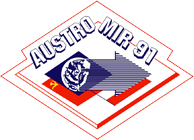The Institute for Applied System Technology (IAS) of the Research Association Joanneum Ges.m.b.H, Graz, was contracted by the ESA to develop a new satellite video-conference system as part of Project DICE (Direct Inter-Establishment Communications Experiment). This system featured numerous improvements compared to conventional devices. Most importantly was the possibility to connect up to four stations together simultaneously over satellite, whereby all conference participants had constant audio-visual contact. With the help of additional computer setups for the transmission of documents, all communication possibilities were managed just like conventional conferences where all participants were situated in the same location. Special attention was given to a fully automatic system so that all participants could use this electronic communication medium without any special training. Conferences on short notice were made possible, as well as participants avoiding additional costs and time-consuming travelling.
The utilization of news satellites allowed a flexible use of the communication medium. Large distances could be over-bridged without any problems. Transportable ground-stations were positioned and operational within a few hours.
A permanent video-conferencing over satellite between Moscow, Vienna and Graz was suggested and adopted as a project during the preparations for the AUSTROMIR-91 mission. Adaptations of the equipment allowed the Austrian project management and experimenters to have live news conferences with journalists and other interested parties in Austria. One could have audio-visual connections with the cosmonauts from the Information Centre in Graz.
Installation of the operation system
The video-conferencing system with the satellites’ ground stations was installed by the IAS at the Flight Control Centre ZUP in Kaliningrad, near Moscow. A connection between ZUP and the Space Station was achieved by installing additional equipment and customizing various television standards.
The AUSTROMIR Information Centre was located in the rooms at the Technical University Graz (Inffeldgasse 12) in Graz. The Information Centre was equipped with its own satellite ground station and the DICE video-conference system.
The Viennese news headquarters was located in the Technical Museum and was equipped with a video-conferencing system by the IAS. A transportable earth station was set up by the Austrian Telecom.
Video-conferences between the Technology Centre ESTEC in Noordwijk, Holland and the TELECOM-91 booth in Geneva were to be provided by the ESA. Grazer video-conferencing systems and ESA’s ground stations were installed in Geneva and Noordwijk.
Functionality
The system is made up of two parts: the conferencing equipment and a satellite ground station that, for example, can be installed on the roof of a building.
The video and audio equipment was brought in compact transportable units. They could be easily deployed without any special acoustic or lighting equipment in any room (office, conference hall or auditorium). Expensive studios are dispended with by using such transportable equipment. Their service is also flexible when different rooms need to be connected together. A fibre-optic transmission system was employed between the equipment in the conference room and the satellite ground stations. These systems could be installed quickly by unsupervised personnel. Just one cable connects the conference units with the satellite transmitters that were erected next to the satellite ground stations.
Document transmission was carried out with the help of a special self-developed computer graphical system that was made up of a personal computer, scanner, laser printer and a high-definition A4 monitor. This additional information transmission happened in parallel with the audio-visual signals.
The commercial news satellite EUTELSAT-I-F2 was used during the AUSTROMIR 91 mission for the sake of availability. The satellite’s footprint ranged from central Europe to Moscow. Relatively small earth stations with 2.4 m offset-antennas were used. All transmitters were directly connected to the antenna, which itself was aligned with the satellite using a simple rotating tripod.
Results
The first connection between ESTEC in Graz and the Russian Space Station MIR took place on 16 September. Despite the required conversion of transmission standards and the digital compression of the pictures, the quality of the transmission was remarkable. Especially the connections to the Space Station though the Russian relay satellites delivered disruption-free pictures over a time-span of nearly an hour.
The first official video-conference between TUP, Graz and Vienna took place on 4 October. Austrian experts in ZUP moderated the flight’s hourly information transmission daily. Numerous journalists as well as private persons took the occasion to discuss the project’s progress and the subject on space travel not only with the project management and the experimenters, but also with the Russian cosmonauts and space specialists.
The climax points during the deployment of VIDEOMIR were the meetings between the Austrian President and Franz Viehboeck after the arrival of the crew on the Space Station, the direct hook-up between Graz and the Space Station during the art project ARTSAT and the video-conferences between ZUP, ESTEC and TELECOM-91. Discussions between aerospace representatives also took place. An example was an insider-discussion between NASA astronaut Russel Schweickart and his Russian counterpart Alexandr A. Volkov. The TELECOM-91 was a remarkable framework for the presentation of the video-conferencing system, leveraging an Austrian high-tech product as well as the publicity of the high-tech project AUSTROMIR.
The European Space Agency ESA supplied a total satellite time of 12 hours during the test phase and an additional 28 hours during the flight. The video-conferencing system functioned exceptionally faultless.
Practical application
The Russians as well as ESA are planning the acquisition of the Austrian system as a result of this successful deployment. The Russian partners want to the deploy VIDEOMIR in the Snamja Project, which is in turn part of the Project Novyj-Svjet. In the framework of Novyj-Svjet, solar sails will be deployed and mirror points will light up the dark-side of the Earth. More contracts can be handled successfully already: Experts conferenced with the help of VIDEOMIR even during the MIR-92 mission and the ESA missions EUROMIR-94 and EUROMIR-95.
Technical characteristics
Satellite ground stations were installed in Kaliningrad (Flight Control Centre ZUP) and in Graz. The stations conformed to the EUTELSAT Standard-3 and had an antenna with a diameter of 2.4 m. The quality factor of the receivers was 25 dB/K and the maximum transmission capacity was 75 W (equivalent to an EIRP of 65.9 dBW). This enabled a secure transmission of digital data with a rate of 2 Mbit/s.
A transportable earth station of the Austrian Telecom, equipped with an antenna of 4.5 m in diameter, was installed at the news centre in Vienna (in the Technical Museum).
Efficient TDS-4 stations with an antenna of 4.5 m from ESA were installed at ESA’s technology centre, at ESTEC in Noordwijk, Holland and at the exhibition grounds of the TELECOM-91 in Geneva.
Three stations were active in a video-conference session at any given time: in Configuration 1, these were located at the Flight Control Centre ZUP, in Graz and Vienna. In Configuration 2, these were located at ZUP, ESTEC and in Geneva. These configurations required three 2 Mbit/s channels constantly.
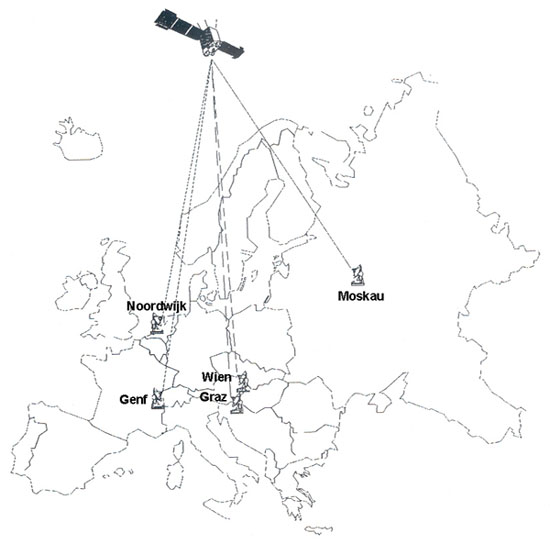
The news satellite EUTELSAT-I-F2 was chosen for the space segment. ESA’s satellite OLYMPUS with a workload of 20/30 GHz was originally planned. The change to a KU band (12/14 GHz) and the EUTELSAT system was necessitated due to a temporary malfunction of OLYMPUS. The disadvantage with this satellite was its orbit’s inclination having a deviation of ± 0.1° in the east-west direction and ± 0.8° in the north-south direction, affecting the daily nominal geo-stationary position of 2° east.
All locations were equipped with DICE video-conferencing units. They consisted of 3 monitors, a television camera, audio transmission equipment as well as video codecs. The last converted analogue TV signals in digital signals and compressed the data down to a ratio of 50:1, whereby qualitatively very good pictures could be transmitted with a data rate of only 2 Mbit/s. A special fibre-optic system connected the conference unit with the modems of the satellite ground stations. A graphical unit was additionally installed, consisting of a scanner, laser printer, monitor and a computer. The transmission of documents through the codec’s 64 Kbit/s data channel was possible during the conference.
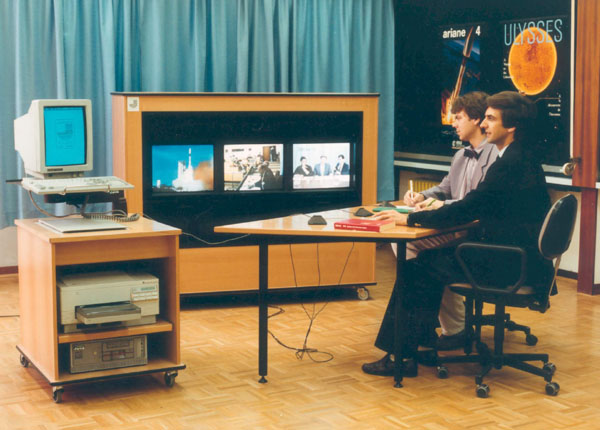
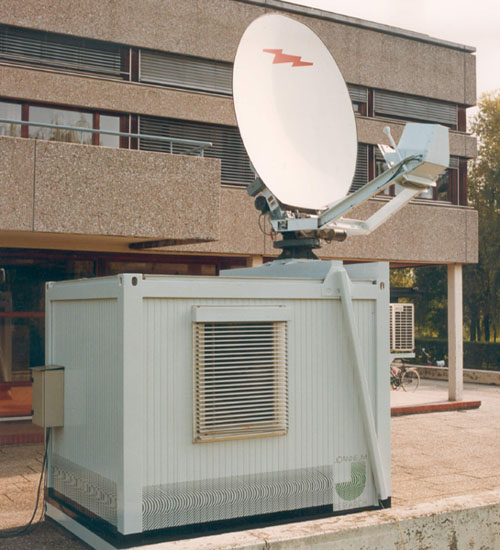
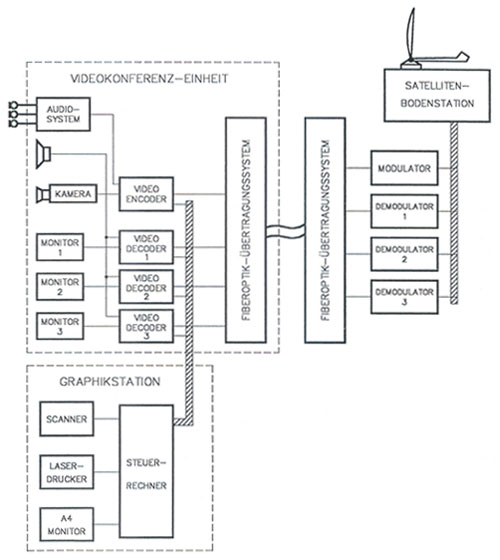
Additional equipment was used at the Flight Control Centre, as a connection with the Space Station was necessary. PAL/SECAM transcoders for the customization of various television standards were installed. The video-conference system was connected with the Flight Control Centre’s transmitters through an audio-visual mixer. Through-connections with the Space Station took place with the help of Russian relay stations or through telemetric stations on the ground. BETACAM recorders were used for the recording of pictures on the Space Station and played later during the video-conference.
Experimenters
o. Univ.-Prof. Dipl.-Ing. DDr. Willibald Riedler (institute manager)
Dipl.-Ing. Dr. Otto Koudelka (project manager)
Dipl.-Ing. Kurt Kerschat
Dipl.-Ing. Christian Netzberger
Ing. Reinhard Stieninger
Ing. Manfred Zierler
all: Institute for Applied System Technology, Research Association Joanneum Ges.m.b.H, Graz
